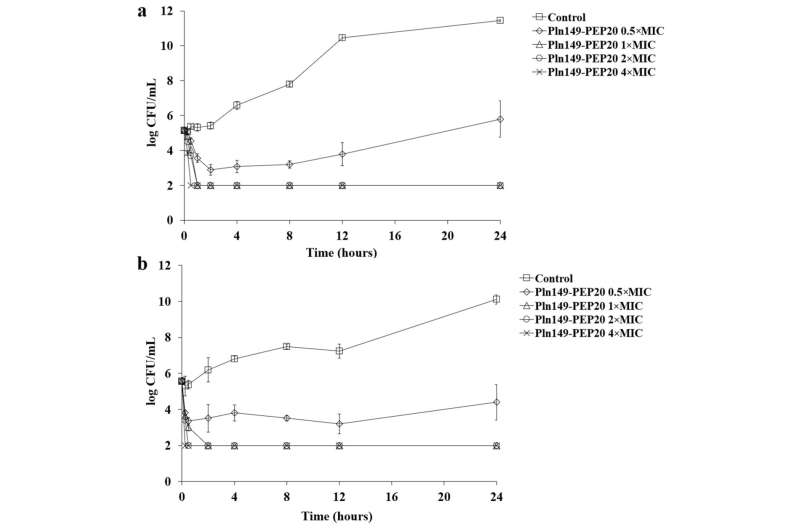This article has been reviewed according to Science X's editorial process and policies. Editors have highlighted the following attributes while ensuring the content's credibility:
fact-checked
trusted source
proofread
Researchers find compound that combats multidrug-resistant bacteria in less than one hour

Resistance to antibiotics is a problem that alarms the medical and scientific community. Bacteria resistant to three different classes of antibiotics, known as multi-drug resistant (MDR) bacteria, are far from rare. Some are even resistant to all currently available treatments and are known as pan-drug resistant (PDR). They are associated with dangerous infections and listed by the World Health Organization (WHO) as priority pathogens for drug development with maximum urgency.
An article published in a special issue of the journal Antibiotics highlights a compound with antibacterial activity that presented promising results within one hour in laboratory trials.
The study was led by Ilana Camargo, last author of the article, and conducted during the doctoral research of first author Gabriela Righetto at the Molecular Epidemiology and Microbiology Laboratory (LEMiMo) of the University of São Paulo's São Carlos Institute of Physics (IFSC-USP) in Brazil.
"The compound we discovered is a new peptide, Pln149-PEP20, with a molecular framework designed to enhance its antimicrobial activity and with low toxicity. The results can be considered promising insofar as the trials involved pathogenic bacteria associated with MDR infections worldwide," said Adriano Andricopulo, a co-author of the article.
Although novel antibacterial drugs are urgently needed, the pharmaceutical industry is notoriously uninterested in pursuing them, mainly because research in this field is time-consuming and costly, requiring very long lead times to bring viable active compounds to market.
The Center for Innovation in Biodiversity and Drug Discovery (CIBFar), a Research, Innovation and Dissemination Center (RIDC), looks for molecules that can be used to combat multidrug-resistant bacteria.
Camargo and Andricopulo are researchers at CIBFar, as are two other co-authors who study promising bactericidal compounds: Leila Beltramini and José Luiz Lopes.
For over a decade, the group formed by the collaboration between Beltramini and Lopes has analyzed Plantaricin 149 and its analogs. Plantaricins are substances produced by the bacterium Lactobacillus plantarum to combat other bacteria.
Lactobacillus plantarum is commonly found in nature, especially in anaerobic plant matter, and in many fermented vegetable, meat and dairy products.
In the case of Plantaricin 149, Japanese researchers were the first to report its bactericidal action (in 1994) and since then scientists have been interested in obtaining more efficient synthetic analogs (molecules with small structural differences).
In 2007, one of the first projects completed by the CIBFar team showed that the peptide inhibits pathogenic bacteria such as Listeria spp. and Staphylococcus spp. They then began studying synthetic analogs with stronger bactericidal activity than the original (causing more damage to the membrane of the combated microorganisms).
Righetto synthesized 20 analogs of Plantaricin 149, finding that Pln149-PEP20 had the best results so far and was also half the size of the original peptide. "The main advances in our research consist of the development of this smaller, more active and less toxic molecule, and the characterization of its action and propensity to develop resistance. It has proven to be highly promising in vitro—active against MDR bacteria and extensively resistant bacteria," said Camargo, principal investigator for the project.
LEMiMo, the laboratory where the studies were conducted, has experience in characterizing bacterial isolates involved in outbreaks of hospital infections and holds a collection of bacteria selected for these trials in search of novel active compounds. The bacteria have the resistance profiles currently of greatest concern and were isolated during hospital outbreaks.
They are known in the scientific community by the term ESKAPE, an acronym for the scientific names of six highly virulent and antibiotic-resistant bacterial pathogens: Enterococcus faecium, Staphylococcus aureus, Klebsiella pneumoniae, Acinetobacter baumannii, Pseudomonas aeruginosa, and Enterobacter spp.
Further research can now be conducted to investigate the molecule's action mechanism in more depth, to look for formulations, and possibly to develop an application.
"In terms of the action mechanism, it's also possible to use the cell morphology of the bacteria to identify cellular pathways affected by the peptide," Righetto said. "As for optimization, the molecule can be functionalized by being linked to macrostructures, and the amino acid sequence can be modified." Research is also needed on its cytotoxicity and on its selectivity (whether it affects healthy cells).
"We're living in times of major global public health hazards due to a lack of antimicrobials that can be used to treat infections caused by extremely resistant bacteria. Antimicrobial peptides are targets of great interest for the development of novel candidate drugs. This novel molecule has the potential to be used as an innovative antimicrobial therapy, but further modifications and molecular optimizations still need to be investigated," Andricopulo said.
More information: Gabriela Marinho Righetto et al, Antimicrobial Activity of an Fmoc-Plantaricin 149 Derivative Peptide against Multidrug-Resistant Bacteria, Antibiotics (2023). DOI: 10.3390/antibiotics12020391
Provided by FAPESP


















